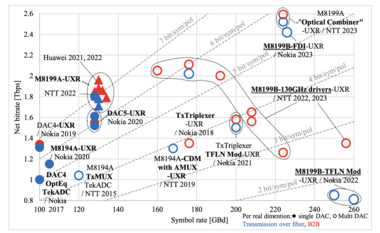Optical transmission: sending more data over a greater reach
 Tuesday, January 30, 2024 at 12:22PM
Tuesday, January 30, 2024 at 12:22PM - Keysight Technologies' chart plots the record-setting optical transmission systems of recent years.
 Source: Keysight Technologies
Source: Keysight Technologies
The chart, compiled by Dr Fabio Pittalá, product planner, broadband and photonic center of excellence at Keysight, is an update of one previously published by Gazettabyte.
The latest chart adds data from last year's conferences at OFC 2023 and ECOC 2023. And new optical transmission achievements can be expected at the upcoming OFC 2024 show, to be held in San Diego, CA in March.
The chart plots optical single-carrier transmission records since 2017. In particular, the systems' net bit rate - from 800 gigabit-per-second (Gbps) to 2.6 terabits-per-second - against the symbol rate measured in gigabaud (GBd). The achieved net bit rate has increased by about a fifth in the last year, up from 2.2Tbps.
The chart also reveals optical transmission performance issues and the importance of the high-speed converters between the analogue and digital domains for test equipment used to drive the systems and, by implication, for coherent digital signal processors (DSPs).
As with commercial coherent optical transport systems, the goal is to keep increasing the symbol rate. A higher symbol rate sends more data over the same fibre spans. For example, the OIF's 400ZR coherent transmission standard uses a symbol rate of some 60GBd to send 400Gbps over a wavelength. The newer 800ZR doubles the baud rate to around 120GBd to transmit 800Gbps over similar distances. The next generation 1600ZR technology will double the symbol rate to 240GBd to achieve 1.6Tbps over the same data center interconnect (DCI) link.
The OIF announced today it has added an 1600ZR+ coherent optical initiative.
Key equipment
Two Keysight test equipment platforms were used for these state-of-the-art research and development systems.
Keysight's M8199B is a high-speed arbitrary waveform generator. The M8199B uses a design consisting of two interleaved digital-to-analogue converters to generate up to eight channels of signals at 200-260 giga-samples-per-second (GSps) and has 90GHz -10dB-bandwidth. The second is Keysight's M8199A AWG, whichcan generate the same number of signals up to 256 GSps with 70GHz -10dB-bandwidth.
 Source: Keysight Technologies
Source: Keysight Technologies
New data
At OFC 2023, NTT achieved back-to-back transmissions of 1.65Tbps at 208GBd and 1.35Tbps at 256GBd. This used the same experimental setup shown by the 2022 'M8199B-130GHz drivers-UXR' data points, but here, NTT improved the digital signal processing with a trellis sequence estimation designed for systems with a severe bandwidth limitation.
At ECOC 2023, held last September in Glasgow, NTT achieved 2.59Tbps at a symbol rate of 224GBd in a back-to-back setup and 2.52Tbps at 224GBd over 80km of standard single mode fibre. Here, the experimental setup used an optical combiner to multiplex two channels of the M8199A AWG.
Also at ECOC 2023, Nokia reported 2.42Tbps at 226GBd over 10km over standard single mode fibre. In this experiment, they multiplexed two channels of the M8199B AWG by using an electrical combiner implemented in the frequency-domain.
For both combiners, a specific DSP is required to generate the digital signal and to compensates for distortions induced by the combiner.
 1600ZR+,
1600ZR+,  Fabio Pittalá,
Fabio Pittalá,  Keysight Technologies,
Keysight Technologies,  M8199B,
M8199B,  NTT,
NTT,  Nokia,
Nokia,  OIF,
OIF,  Optical transmission in
Optical transmission in  ECOC 2023,
ECOC 2023,  OFC 2023,
OFC 2023,  OFC 2024
OFC 2024  Print Article
Print Article 


Reader Comments